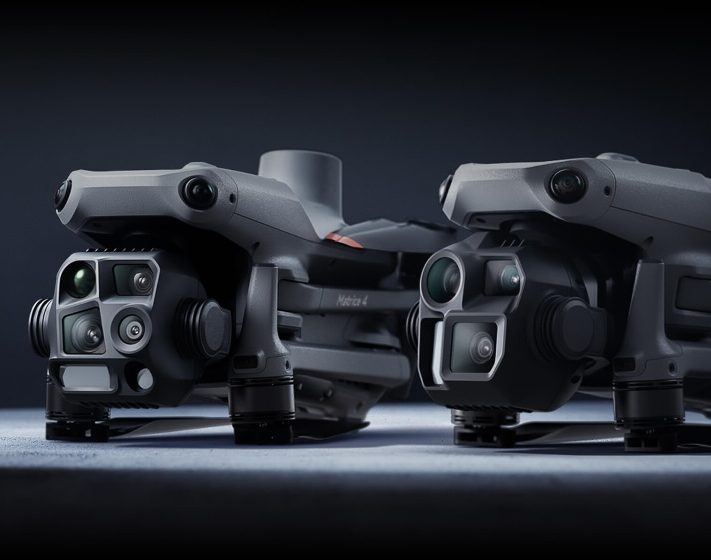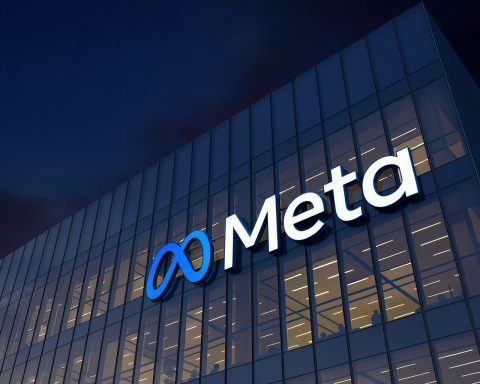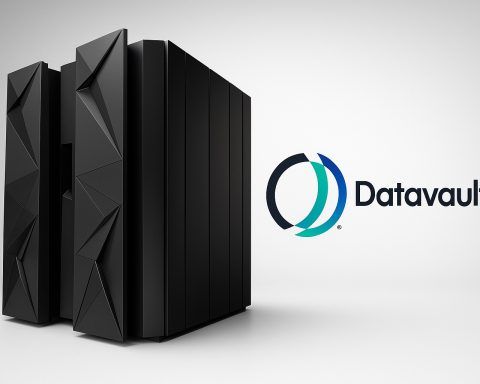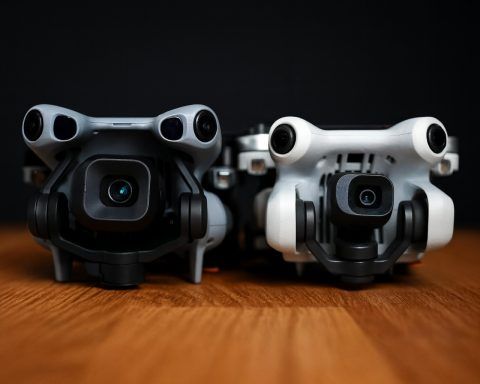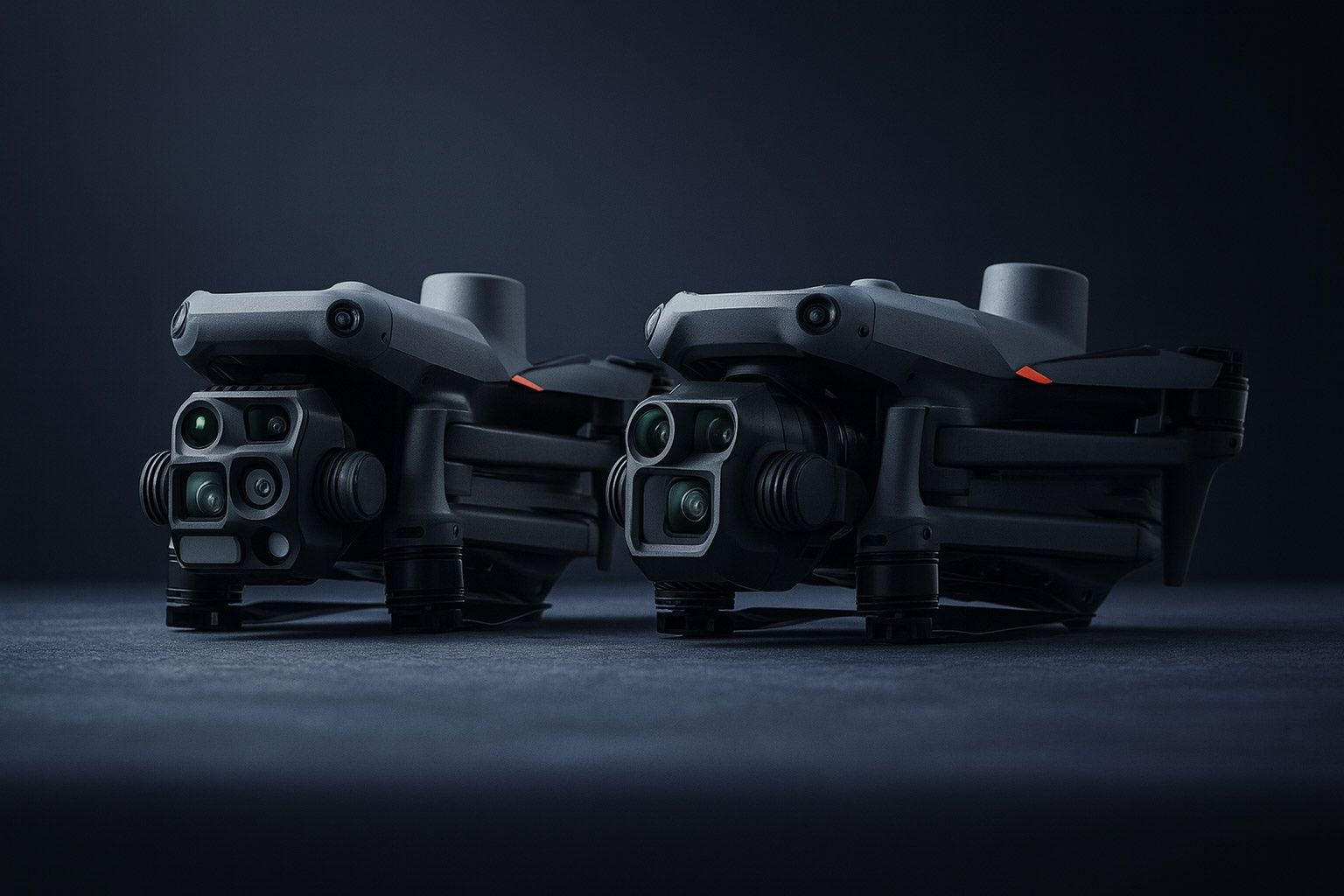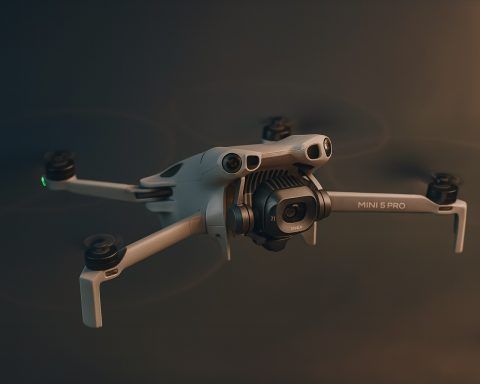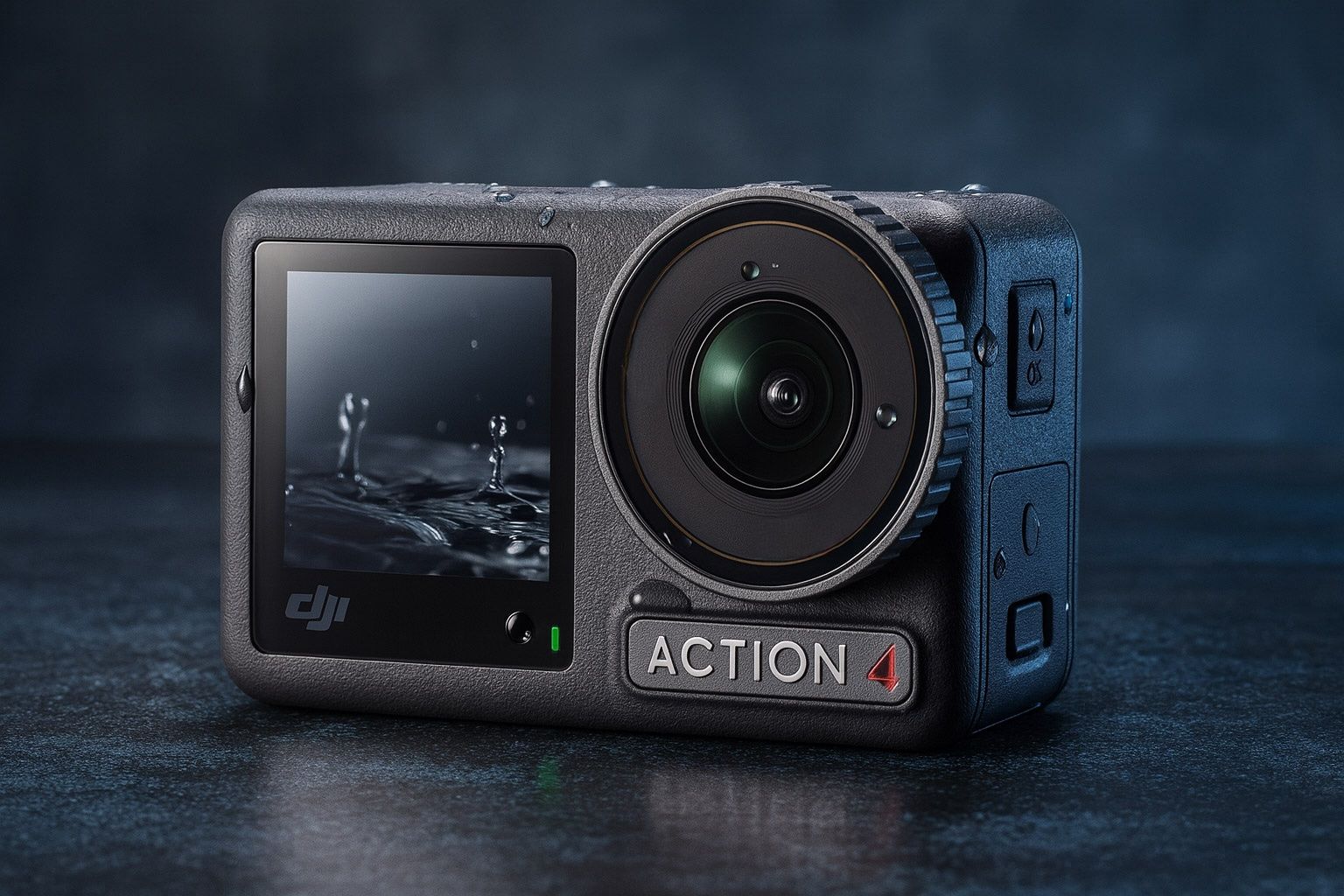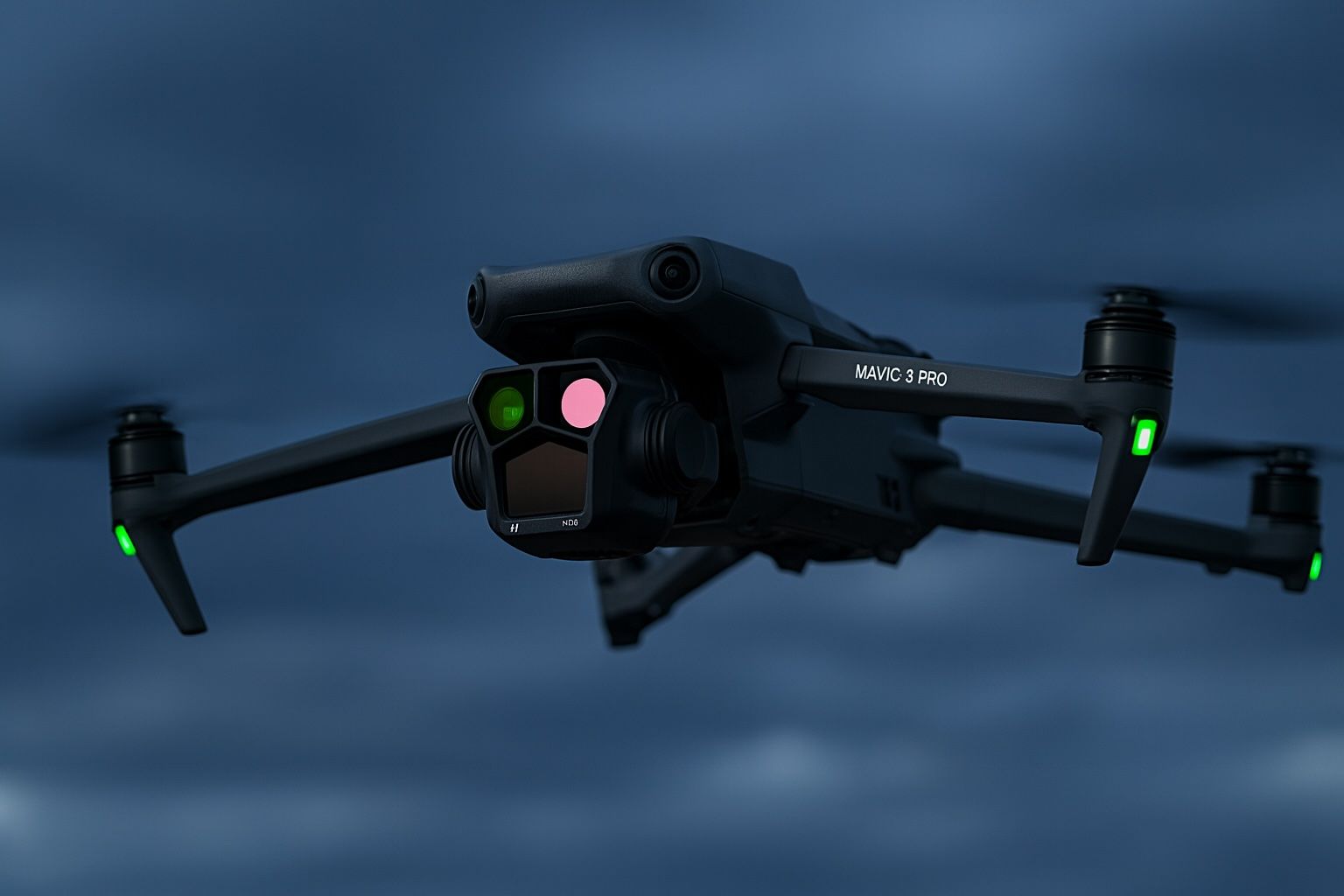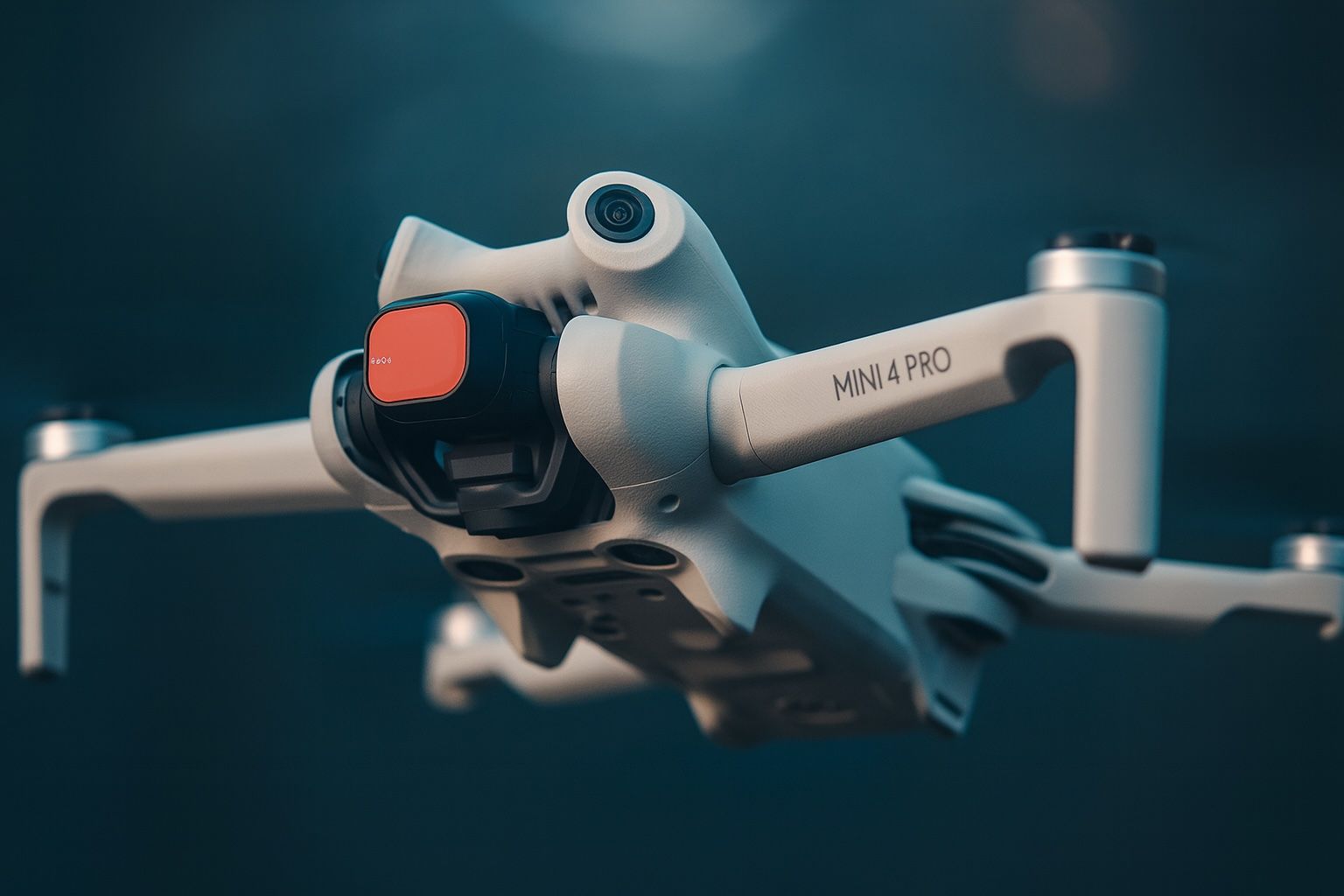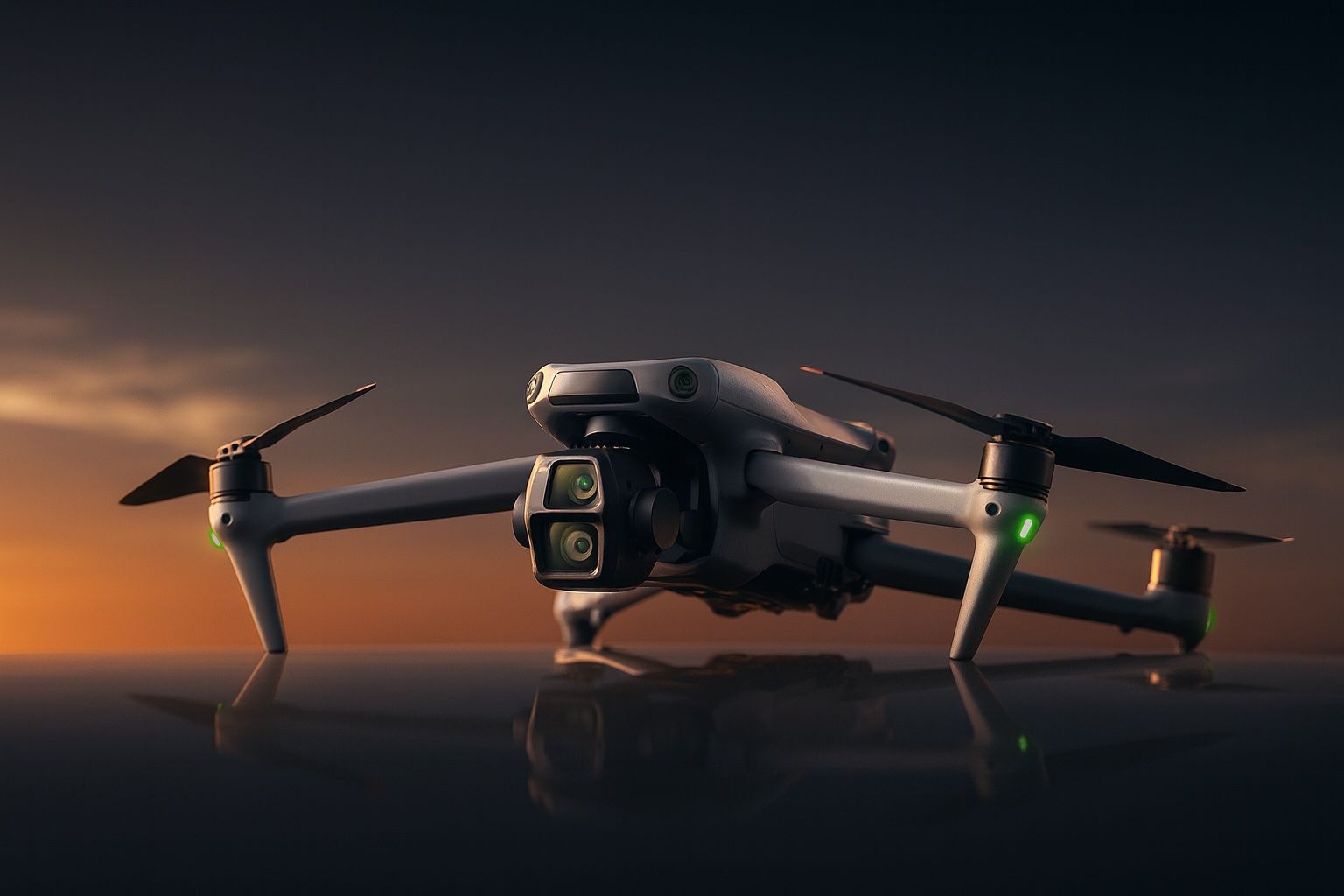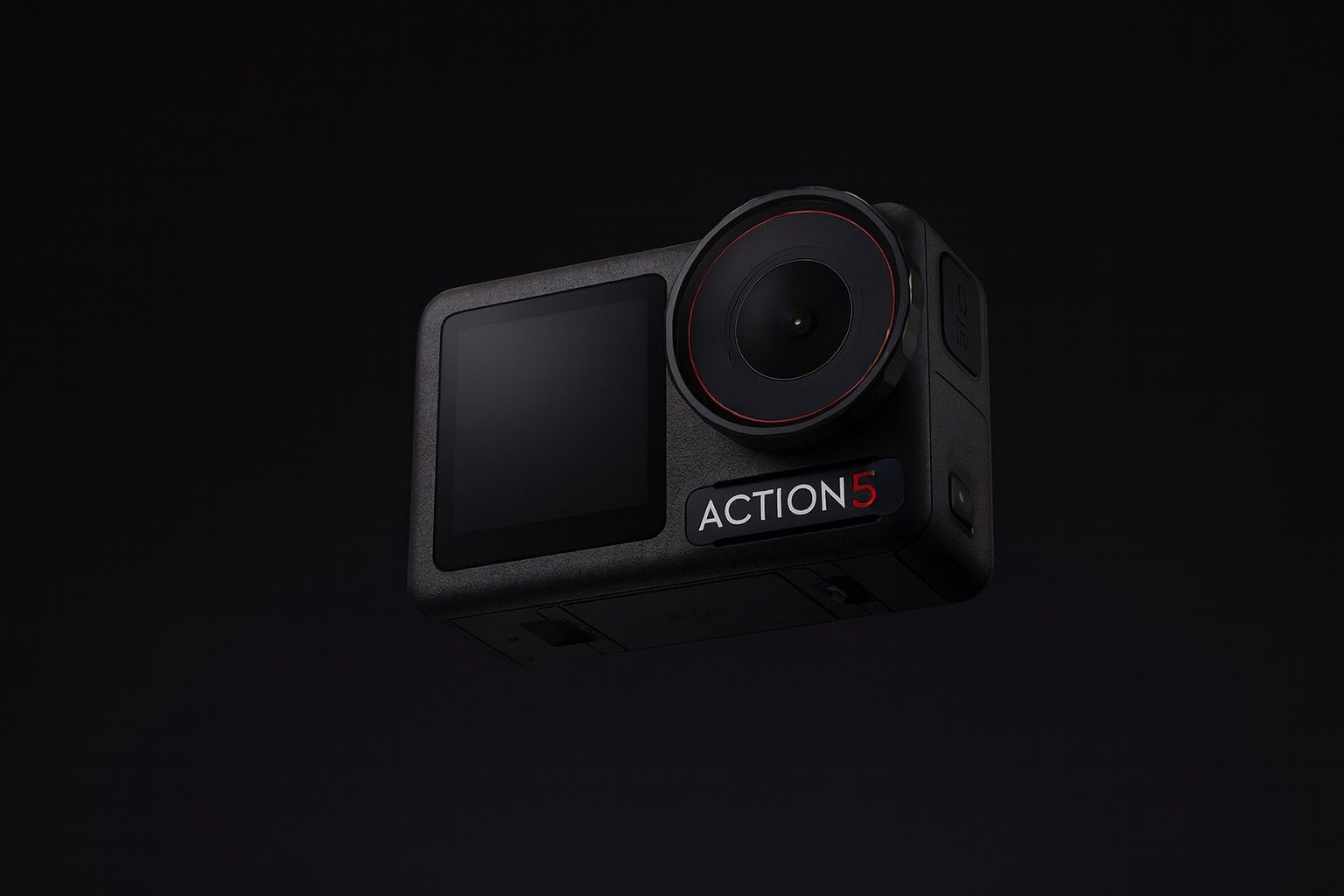- The Matrice 350 RTK (M350) is the flagship successor to the Matrice 300 RTK, offering up to 55 minutes of flight time with no payload, up to 20 km O3 Enterprise range, IP55 weather resistance, and a top speed around 23 m/s.
- The Matrice 30T blends portability with a built-in multi-sensor payload—12 MP wide, 48 MP tele with 5× optical and 200× digital zoom—and a radiometric thermal camera (640×512), enabling about 41 minutes of flight and IP55 protection with hot-swap TB30 batteries.
- The Matrice 4 Series comprises the M4E and M4T with a triple-camera gimbal (48 MP wide, 3× tele, 7× tele) that supports up to 16× optical and 128× hybrid zoom, while the M4T adds a radiometric 640×512 thermal camera and a night-vision NIR illuminator.
- The Matrice 4 Series adds on-board AI for object detection, SmartTrack, 5-directional oblique mapping, and Smart 3D Capture, with 8-antenna O4 Enterprise links delivering up to 12 km CE / 20 km FCC range and 15-second takeoff with the RC Plus 2 controller.
- The Mavic 3 Enterprise series (M3E, M3T, M3M) are compact around 915 g, offer 36–45 minutes of flight time, up to 15 km range, 5-direction obstacle sensing, and optional RTK, but are not IP-rated.
- The M3E uses a 20 MP 4/3″ wide camera with a mechanical shutter and a 12 MP tele, with up to 56× hybrid zoom and can map about 2.25 km² per flight at 5 cm GSD when paired with RTK.
- The M3T adds a radiometric thermal camera (640×512, 30 Hz) alongside a 48 MP RGB main camera and a 12 MP tele, with split-screen thermal/visible views in real time and an approximate price of $6.3k–$6.6k.
- The Mavic 3M multispectral drone bundles a 20 MP RGB camera with four 5 MP multispectral sensors (Green, Red, Red Edge, NIR), enabling NDVI/NDRE mapping and surveying up to roughly 200 hectares per flight.
- DJI’s legacy enterprise options include the Mavic 2 Enterprise family and Phantom 4 RTK/Multispectral, with Zenmuse XT/XT2 and H20T cameras that extended thermal and multi-sensor capabilities across larger drones.
- In practice, RGB mapping favors M3E/M4E for efficiency, large-scale or high-detail surveys lean toward Matrice 300/350 or M4, and SAR/public-safety work tends to use M30T, M4T, or M3T depending on weather, range, and budget.
Introduction: DJI’s enterprise drone lineup has expanded into a versatile range of Matrice and Mavic Enterprise models, each tailored to specific professional needs. From heavy-lift platforms to portable thermal imaging drones, DJI offers solutions for surveying, industrial inspection, search and rescue (SAR), agriculture, and more. In this comprehensive 2025 guide, we compare all major DJI Enterprise drones – including the Matrice 300/350 series, Matrice 30 series, Matrice 4 series, and Mavic 3 Enterprise series – highlighting their core features, specs, use-case suitability, and pricing. Whether you need centimeter-accurate mapping or a rugged thermal drone for emergency response, this report will help you choose the right tool for the job.
DJI Matrice 300 & 350 RTK – Heavy-Lift Flagship Drones
DJI’s Matrice 300 RTK (M300) and its successor the Matrice 350 RTK (M350) represent the flagship heavy-duty platforms for enterprise. Built tough and highly configurable, these drones are workhorses for large-scale operations and demanding environments. The M300 set the industry standard for versatile commercial UAS, and the improved M350 raises the bar further [1] [2].
- Flight Performance: The M350 RTK offers up to 55 minutes of flight time (no payload) – an upgrade over the M300’s ~45 min – giving pilots longer operation per sortie [3]. It also features DJI’s O3 Enterprise transmission for triple-channel 1080p video feeds and up to 20 km range [4]. Both M300/M350 can endure strong winds and wide temperatures (M350 operates from -20°C to 50°C). The M350’s maximum horizontal speed is ~23 m/s (51 mph), ensuring it can cover large areas quickly.
- Payload & Camera Options: Unlike smaller drones, Matrice 300/350 have modular gimbal mounts supporting multiple payloads up to ~2.7 kg [5]. This means you can attach high-end sensors like the Zenmuse P1 (45 MP full-frame photogrammetry camera), Zenmuse H20/H20T (zoom/thermal multi-sensor) or even LiDAR units. This flexibility is critical for applications like survey mapping, LiDAR scans, multispectral imaging, or dropping payloads (e.g. life vests in SAR). The M350’s payload capacity and expansion ports allow operators to tackle diverse tasks with one platform [6].
- Rugged Reliability: Both drones are designed for harsh conditions. The M300 had IP45 weather sealing, while M350 improves to IP55 (better water/dust resistance) [7]. The M350 also enhanced the FPV camera for safer low-light navigation and added an arm-lock detection to prevent improper setup [8]. With six-directional binocular vision + IR sensors, these drones have omnidirectional obstacle sensing for collision avoidance [9]. They can even integrate a top-mounted radar for detecting small obstacles (e.g. power lines) up to 30m [10]. Such redundancies and sensors make them extremely reliable, suitable for critical operations in public safety and infrastructure inspection.
- Use Cases: The Matrice 300/350 are ideal for large-scale and high-risk missions. In energy and infrastructure inspections, they carry zoom cameras to inspect powerlines, wind turbines or oil rigs in detail from a safe distance. For mapping & surveying, an M300/M350 with an RTK module and camera (like P1) can achieve centimeter precision over vast areas. In search & rescue, their endurance and payload capacity let teams search wide areas and even deliver emergency supplies. DJI notes that these flagships are used as life-saving tools worldwide, enabling operations “with increased safety and effectiveness” compared to traditional methods [11]. Pricing: The M350 RTK aircraft starts around $10,300 (drone + controller, no batteries). Complete kits (with multiple batteries, chargers, and DJI Care Enterprise) run in the ~$12K–$14K range depending on options [12]. (Note: payloads like the H20T camera are additional, often costing as much as the drone itself.)
DJI Matrice 30 Series (M30 & M30T) – Portable Powerhouses
Introduced in 2022, the Matrice 30 series delivers much of the capability of the M300 in a more compact, foldable form factor [13]. The M30 drones bridge the gap between large Matrice rigs and smaller Mavics, offering a balance of power and portability. Two versions exist: the standard M30 and the M30T (which adds a thermal camera).
- Integrated Multi-Sensor Payload: Unlike the M300 which uses swappable gimbals, the M30 comes with an integrated camera gimbal. Both M30 and M30T carry a 3-sensor array: a 12MP wide camera, a 48MP telephoto camera (5× optical, 200× max digital zoom), and a laser rangefinder (up to 1,200m) [14]. The M30T adds a fourth sensor – a radiometric thermal camera (640×512 px) – similar in concept to the Zenmuse H20T but built-in [15] [16]. This all-in-one payload means the M30T can capture high-resolution zoom visuals and thermal imagery simultaneously, extremely useful for public safety and inspections. Example: Inspectors can zoom in on a solar panel and also see its heat signature to detect faults, without swapping cameras.
- Performance & Durability: The Matrice 30 series has a max flight time of ~41 minutes [17], a top speed around 23 m/s, and is foldable for transport (fits in a backpack). Critically, it retains an IP55 weather rating like the M300/M350 [18]. This means M30 drones can fly in rain, snow, or dusty environments – a must for emergency response scenarios that don’t wait for clear weather. They operate between -20°C to 50°C and withstand winds up to ~15 m/s [19]. The M30 uses dual TB30 batteries supporting hot-swap and 400 charge cycles, and it ships with the DJI RC Plus controller (7-inch screen) for rugged field use [20].
- Portability & Rapid Deployment: Weighing ~3.7 kg (8.2 lb) takeoff weight [21], the M30 is much smaller and lighter than an M300 (~9 kg with batteries). Its foldable design and quick setup (<1 minute) let teams deploy it extremely fast. DJI describes the M30 as “a M300 in a slightly larger Mavic-like body” – essentially a compact backpackable unit that still packs enterprise-grade sensors [22]. This makes it popular with first responders and field teams who need to move often. For example, a fire department can easily carry an M30T in a vehicle, deploy at an incident in under two minutes, and benefit from thermal imaging and 200× zoom on the spot.
- Use Cases: The Matrice 30T has been hailed as “the perfect search and rescue drone” by many in public safety. It’s purpose-built for law enforcement, firefighting, and SAR – offering both aerial thermal views for finding people or hotspots and optical zoom to identify details, all in a weather-proof, quick-launch package. DJI’s Christina Zhang (Senior Director of Strategy) emphasized that with the M30’s performance, portability and integration with DJI FlightHub 2 and Dock systems, DJI is delivering “the next generation of aerial tools that will save lives and bring work to new heights” [23]. Beyond public safety, the M30 is used for industrial inspections (power lines, cellular towers, wind turbines) where teams benefit from its zoom/thermal combo without needing a big crew. It also fits mapping and surveying of mid-sized areas – the 12MP wide camera (no mechanical shutter) can map smaller sites, though for high-precision mapping the Mavic 3E or P4 RTK still have an edge in camera specs. The M30T’s versatility across scenarios makes it a true “jack of all trades” for enterprise fleets that need one drone to do a bit of everything.
- Pricing: At launch the Matrice 30T combo was around $13,999, but DJI significantly dropped the price in mid-2023 to broaden adoption. As of 2023, an M30T (with 2 batteries and DJI Care) retailed for about $9,637 [24], while the M30 (no thermal) was about $7,133 in a similar kit [25]. This aggressive pricing (likely to compete with rivals like Autel’s Evo II/Max series [26]) makes the M30 series an even more attractive value for agencies. In short, you get a rugged multi-sensor drone under $10K that previously might have cost twice that. (Each package includes the drone, RC Plus controller, two TB30 batteries, and charging station.)
Matrice 4T (left) and 4E (right) – DJI’s new Matrice 4 Series brings enhanced multi-sensor payloads and AI capabilities in a compact, weather-hardened drone [27] [28].
DJI Matrice 4 Series (M4E & M4T) – Next-Gen Compact Flagship
In late 2024, DJI unveiled the Matrice 4 Series (M4 Series) as the next evolution of its enterprise drones. The Matrice 4 Enterprise (M4E) and Matrice 4 Thermal (M4T) improve upon the M30 series with upgraded sensors, AI, and flight performance, effectively redefining the high-end of compact enterprise drones [29] [30]. The M4 Series is designed to handle complex operations that demand multiple sensing modalities and intelligent automation.
- Advanced Multi-Camera Payload: Both M4E and M4T come with a built-in triple-camera gimbal offering wide, medium, and tele cameras – a significant step up from the dual-camera setup on the M30. The wide-angle camera is a 48 MP 1/1.3″ CMOS (f/1.7) for improved low-light imaging [31]. The telephoto system actually includes two zoom cameras: a medium tele with 3× optical and a long tele with 7× optical (48 MP 1/1.5″ sensor), enabling 16× optical zoom total, or up to 128× hybrid zoom [32] [33]. In practice, the Matrice 4 can read details like license plates from 250 m away thanks to the stabilized 7× lens [34] [35]. The M4T model additionally carries a radiometric thermal camera (640×512 @ 30 Hz), comparable to the M30T’s resolution [36]. Uniquely, M4T supports a “super-resolution” thermal mode producing 1280×1024 images for greater detail [37] [38]. It also has a built-in near-infrared (NIR) illuminator to aid the thermal imager in darkness [39]. Essentially, the M4T is a powerhouse for night operations – combining thermal, low-light starlight vision, and laser rangefinder into one. (Both models include a laser rangefinder for accurate target distance/coordinates, similar to M30’s.)
- AI and Smart Features: The Matrice 4 series introduces on-board AI capabilities that streamline complex missions. These drones can perform real-time object detection and recognition (identifying people, vehicles, vessels) and support custom AI models for specific target types [40]. Intelligent flight modes like SmartTrack (auto-track moving subjects), FlyTo points, and automated oblique photography make data capture far more efficient [41] [42]. For example, the M4E can do 5-directional oblique mapping (capturing angled photos on all sides), increasing 3D mapping efficiency by 40% versus the M3E’s 3-directional capture [43]. Another new feature is Smart 3D Capture, which automates complex structure scans and modeling tasks that previously required manual piloting [44] [45]. In essence, the M4 drones not only carry better sensors, but also help the pilot fly smarter, reducing workload and training requirements.
- Flight Performance & Reliability: Despite the huge capability jump, the Matrice 4 drones remain relatively compact (about 4–4.5 kg takeoff weight) – only slightly larger than the M30. They boast a max flight time of 49 minutes [46], and a top speed of 21 m/s [47]. Crucially, they are designed for “field abuse”: IP55 weather-sealed, -20°C to 50°C operating range, with self-heating batteries for cold conditions [48] [49]. An upgraded O4 Enterprise transmission system uses 8 antennas for robust 1080p video links up to 12 km (CE) / 20 km (FCC) and higher data bandwidth [50] [51]. The M4 can also take off in just 15 seconds for rapid response [52]. DJI introduced a new RC Plus 2 Enterprise controller with the M4 – featuring a 7-inch ultra-bright display (1400 nit), 4G connectivity, and even longer battery life [53] [54]. Overall, the Matrice 4 series brings enterprise-grade redundancy and reliability: multiple GNSS + vision positioning systems, omnidirectional sensing via six fisheye cameras, and advanced flight safety features (e.g. auto home-point updates via visual positioning, terrain follow, advanced RTH path planning) [55] [56]. It’s clear these drones are built to keep flying “in conditions where most drones (including Mavic) would be grounded.” [57] [58]
- Use Cases: The M4E and M4T are tailored to specific missions: M4E is optimized for geospatial surveying and 3D mapping, while M4T is optimized for public safety, emergency response, and industrial inspection [59]. For mapping professionals, the M4E’s 20MP 4/3 camera with mechanical shutter and 0.5 s shooting interval offers near-photogrammetry-grade imagery, enabling extremely efficient coverage (DJI claims up to 5,200 images per flight and up to 2.25 km² mapping in one go) [60] [61]. Meanwhile, the M4T is a dream for SAR and security operations: its enhanced thermal imaging with dual-vision fusion and AI detection allows finding persons or hotspots faster and more reliably than ever. For example, the Night Scene mode + NIR light on M4T can spot a missing person in darkness or see through smoke better than earlier systems [62] [63]. Inspectors of power grids or telecom towers will appreciate the 16× optical zoom clarity to see tiny details (like a cracked insulator or loose bolt) from a safe standoff distance [64] [65]. The M4T essentially combines the strengths of M30T and M300/H20T into a single integrated unit, and then boosts them with AI and better zoom – making it arguably the most advanced compact inspection drone in DJI’s lineup as of 2025.
- Pricing & Availability: The Matrice 4 series hit the market in late 2024. Notably, pricing is lower than previous Matrice kits, likely due to efficiencies of integration. The M4T (thermal) has an MSRP around $6,999 for the drone and standard kit [66], making it substantially cheaper than the older M30T’s initial price. Even fully-loaded bundles (with extra accessories for wildlife tracking or public safety) are in the ~$8–10K range [67]. The M4E (survey variant) is priced around $4,799 base [68] – a bit higher than the Mavic 3 Enterprise, but it offers a bigger sensor and more capabilities. These aggressive prices mean enterprises can get cutting-edge tech at a mid-range cost. (However, note that U.S. availability may be affected by regulatory restrictions on Chinese-made drones – some dealers indicated limited stock of M4 series as of 2025.)
In summary, the Matrice 4 Series brings “unmatched precision, advanced AI, and versatile payloads” in a compact form [69]. It’s the new go-to for professionals who need the absolute best imaging and automation, without stepping up to a full-size heavy-lifter.
DJI Mavic 3 Enterprise Series (M3E, M3T, M3M) – Compact & Versatile
DJI’s Mavic line isn’t just for consumers – the Mavic 3 Enterprise series (released late 2022) adapts the proven Mavic 3 drone into industrial-grade tools. These folding quadcopters offer a compelling mix of portability, affordability, and enterprise features, effectively succeeding the older Mavic 2 Enterprise models. The series includes: Mavic 3 Enterprise (M3E) for mapping/optical imaging, Mavic 3 Thermal (M3T) for thermal imaging, and Mavic 3 Multispectral (M3M) for agricultural surveys.
- Shared Platform Features: All Mavic 3 Enterprise variants are small and lightweight (~915 g takeoff), with folding arms that collapse into a backpack-friendly form [70] [71]. They use the same airframe and battery as the consumer Mavic 3, but with specialized payloads and the DJI RC Pro Enterprise controller (5.5” high-bright display) [72]. Flight time is 36–45 minutes (real-world ~35 min typical) on a single charge [73], and max speed ~15 m/s. They have omnidirectional obstacle sensing (5-directional) and advanced RTH/APAS safety features like the consumer model [74]. However, note Mavic 3 Enterprise drones are not IP-rated and lack battery heaters [75] [76] – they handle light rain and moderate wind, but are not meant for foul weather or extreme cold without precautions. All support DJI’s RTK Module as an add-on for centimeter GPS precision and TimeSync (important for accurate mapping) [77]. They also can use DJI’s modular Enterprise accessories: e.g. a loudspeaker (for broadcasting messages or siren – useful in police or wildlife ops) and an LED beacon. Crucially, the M3 Enterprise series integrates with DJI’s enterprise software ecosystem like FlightHub 2 (fleet management and live mission streaming) and DJI Terra (mapping/3D modeling software) [78] [79].
- Mavic 3 Enterprise (M3E): The M3E is built for surveying and mapping. It features a 20 MP 4/3-inch CMOS wide camera with a mechanical shutter [80] – this is a big deal for mapping, as the mechanical shutter eliminates motion blur during fast flight and enables rapid image capture (the M3E can shoot at 0.7 s intervals, versus ~2.5 s on a standard Mavic 3) [81]. The large 4/3 sensor (same size as a Micro Four Thirds camera) yields high image quality and better low-light performance for inspection photos. In addition, the M3E has a secondary tele camera (12 MP, 1/2″ CMOS) offering up to 56× hybrid zoom (approximately 7× optical + digital) [82]. This zoom isn’t as powerful as the Matrice’s, but it allows operators to inspect details like a roof damage or cell tower component from a safe distance. With the RTK module attached, the M3E achieves centimeter-level positioning for mapping tasks, and DJI reports it can map up to ~2.25 km² per flight at 5 cm GSD (using proper altitude) [83]. In practical terms, the M3E has largely replaced the Phantom 4 RTK as the go-to compact mapping drone – it’s “better in every way (image quality, flight time, obstacle avoidance… while being much easier to deploy)” than the Phantom 4 RTK [84]. Use cases include cadastral surveys, construction site mapping, accident scene reconstruction, and any scenario where you need a quick aerial map without mobilizing a large UAV. Note: The M3E’s camera can also serve for general photography/videography in inspections, though it lacks the extreme zoom or thermal of other variants.
- Mavic 3 Thermal (M3T): The M3T is geared toward public safety and inspection missions that require thermal imaging. It carries two cameras: a 1/2″ CMOS wide camera (48 MP) for normal RGB imaging, and a radiometric thermal camera (640×512 resolution, 30 Hz) [85] [86]. It also retains a 12 MP telephoto for up to 56× zoom (similar optics as M3E’s tele) [87] [88]. The wide-angle on M3T is actually higher megapixel (48MP vs 20MP on M3E) but on a smaller sensor and without a mechanical shutter [89] – meaning the M3T’s visible imagery isn’t as sharp for mapping detail, but still very good for live situational awareness and documentation. The thermal sensor is the star: it supports spot temperature measurement, area temperature stats, high temperature alerts, isotherm palettes, etc. Firefighters, police, and industrial inspectors use the M3T to spot heat signatures – e.g. finding a missing person in darkness, detecting a hidden fire hotspot, or spotting an overheating fuse on a power line. The M3T’s controller offers split-screen view to display thermal and visual feed side-by-side in real time [90], which is great for quickly correlating what you see in IR vs visible. While the M3T can also perform mapping (including thermal orthomosaics) and carry the RTK module, the survey accuracy is a bit less than M3E due to the rolling shutter and smaller sensor [91]. DJI suggests that if high-precision survey is needed, the M3E is preferable [92]. In essence, the M3T is a portable thermal workhorse for smaller-scale jobs: routine roof inspections, quick solar farm scans, accident response, or police surveillance (it’s quiet and unintrusive). Public safety teams often value that the M3T can be in the air in under 2 minutes and deliver both color and heat imagery for situational intel.
- Mavic 3 Multispectral (M3M): Released in late 2022, the M3M (also called Mavic 3 M) is tailored to precision agriculture and environmental monitoring. It has a unique payload consisting of five cameras: the same 20 MP 4/3-inch RGB camera (mechanical shutter) as the M3E, plus a multispectral array of 4× 5 MP sensors (Green, Red, Red Edge, Near-Infrared bands) [93]. These capture reflectance data needed to generate vegetation indices (like NDVI, NDRE) which help assess crop health. The M3M includes an ambient light sensor for calibration and supports RTK for geo-referencing. It can survey up to 200 hectares per flight (~500 acres) at the recommended settings [94] [95] – vastly improving efficiency for farm mapping. Essentially, the M3M condenses the capabilities of the older Phantom 4 Multispectral into a folding Mavic body, with longer flight time and better portability. Farmers and agronomists use it to monitor crop growth, detect stress or disease early, and optimize inputs. Beyond agriculture, environmental researchers can use the multispectral data for forest surveys, water quality (algae bloom detection), or land management. The M3M still carries the telephoto camera too, so it can double as a normal enterprise drone when needed. Its pricing is around $5,500–$5,700 (including 1 year DJI Care) [96] – a very cost-effective price for a multispectral UAV.
- Use Case Overview: The Mavic 3 Enterprise series redefines what “small drones” can do for industry. They are ideal for teams that need high mobility and quick deployment over absolute top-end specs. For example, a telecom technician can throw an M3E in the truck, and when at a site, launch it to capture inspection photos of a cell tower within minutes (versus scheduling a crane or climbing). A police unit can keep an M3T on hand for thermal night surveillance of a search area or to manage a crowd event with an eye in the sky. Surveyors can carry multiple M3Es in a backpack to remote sites and map rough terrain that’s hard to access on foot. While larger Matrice drones might handle extreme conditions and heavy payloads, the Mavic 3 Enterprises excel at everyday missions that require agility. As one pilot put it, the M3 series is “a powerful tool… so far I am SUPER impressed” with how much capability it packs in a small package [97].
- Pricing: One big advantage of the Mavic 3 Enterprise line is affordability relative to larger drones. The base Mavic 3E starts around $3,899 (including a basic Care plan) [98]. The Mavic 3T (thermal) runs around $6,300–$6,600 for the basic combo [99] [100]. These prices include the drone, the RC Pro Enterprise controller, one battery, and chargers (varies by bundle). Additional fly-more kits with more batteries are available. Even fully equipped kits with extended warranties rarely exceed ~$7K for the M3T or ~$5K for M3E [101]. This puts advanced capabilities (mechanical shutters, 640px thermal, etc.) within reach of smaller organizations and budgets. By contrast, the previous Matrice 210 + Zenmuse XT2 thermal combo could cost 3–4× that amount a few years ago. It’s worth noting DJI offers “Worry-Free” Enterprise service plans (Care Basic/Plus) for these drones, which cover accidental damage – many distributors sell the combos with 1 or 2 year coverage built-in, as reflected in the prices above [102] [103].
Other Notable Enterprise Models & Thermal Solutions
While the focus is on current flagship models, it’s useful to mention a few legacy or specialized DJI drones that have served enterprise users, especially in thermal imaging:
- Mavic 2 Enterprise Series (Zoom / Dual / Advanced): Predecessor to the M3 series, the Mavic 2 Enterprise (M2E) launched in 2018 and became popular with police and inspection crews. The M2E Zoom had a 2× optical/3× digital zoom RGB camera, and the M2E Dual added a FLIR thermal microcamera (160×120 resolution) for basic thermal capability. In 2021 DJI released the Mavic 2 Enterprise Advanced with a vastly improved 640×512 thermal sensor and a 48MP visual camera, plus optional RTK module. The M2E Advanced was essentially a mini-Matrice in its time, and enabled many public safety agencies to adopt thermal drones affordably. However, it lacked the flight time, obstacle sensing and camera quality of the newer Mavic 3T. As of 2023, the Mavic 2 Enterprise line has been phased out in favor of the Mavic 3 Enterprise (which, as noted, outperforms it in every metric).
- DJI Phantom 4 RTK & Phantom 4 Multispectral: These are not thermal drones, but worth noting for surveying and agri sectors. The Phantom 4 RTK (2018) was a workhorse for mapping with its 20MP 1-inch sensor and built-in RTK module, achieving ~2.7 cm accuracy [104]. Many surveyors still use P4 RTKs for base mapping and volumetric surveys. The Phantom 4 Multispectral (2019) similarly had a 6-camera array (RGB + 5 multispectral bands) for crop analysis. Now, the P4 RTK is largely replaced by the Mavic 3E (which is easier to deploy and has better obstacle avoidance) [105], and the Mavic 3M supplants the P4 Multispectral with longer flight time. Nonetheless, DJI continues to support these Phantom models, and they remain entry-level enterprise drones for organizations that have them.
- Zenmuse XT, XT2, H20T Cameras: DJI has provided thermal imaging via gimbal cameras that mount on Matrice series. The original Zenmuse XT (2015, in partnership with FLIR) and later XT2 (with dual thermal/visible sensors) allowed Matrice 200 and 600 drones to perform thermal inspections. The Zenmuse H20T, introduced with Matrice 300, is a quad-sensor payload (20MP zoom, 12MP wide, Laser RF, 640px thermal) and essentially delivers similar capability to an M30T on the larger Matrice. For users who need thermal on the M350, the H20T is the go-to, providing 20× optical zoom plus thermal in one gimbal [106]. This flexibility means an M350 can do everything an M30T can, albeit with a heavier, more expensive setup – but also with longer flight time and greater payload flexibility (e.g., carrying both an H20T and a separate camera or spotlight).
- Agricultural Spraying Drones: A separate class of DJI enterprise drones, the Agras series (e.g. T30, T40) are built for crop spraying and spreading, not imaging. They carry large tanks (30–40 liter) and use radar for terrain following. While beyond the scope of this imaging-focused comparison, it’s worth noting for agricultural use-cases: one might use a Mavic 3M to survey fields and identify issues, then deploy an Agras drone to precisely spray those areas. DJI is increasingly providing this end-to-end farm solution, linking survey data to targeted action.
In summary, DJI’s ecosystem covers everything from tiny thermal quads to big heavy-lift hexacopters. Older models paved the way, but new models have swiftly taken the lead in capability.
Thermal vision from a DJI Enterprise drone (Matrice series) detecting heat signatures on terrain. High-resolution thermal sensors (640×512 or greater) on drones like the M3T, M30T, and M4T enable critical applications in firefighting, search & rescue, and equipment inspection [107] [108].
Spec Comparison Table: Key Features of Major DJI Enterprise Drones
To crystallize the differences, below is a side-by-side comparison of key specs for DJI’s main enterprise drone models:
| Drone Model | Main Camera & Sensor | Thermal Camera | Zoom | Flight Time | Max Range | Weather Rating | Takeoff Weight | Notable Features | Typical Price* |
|---|---|---|---|---|---|---|---|---|---|
| Matrice 350 RTK | No built-in camera (supports Zenmuse P1, H20 series, etc.) – e.g. 20MP 1″ or 45MP FF | Optional (via Zenmuse H20T or XT2 payload) | Up to 200× digital (with H20T: 20× optical + digital) | Up to 55 min [109] | 15 km (OcuSync 3 Ent) [110] | IP55 (dust & rain) [111] | ~6.3 kg (aircraft only) | Heavy lift (2.7 kg payload) [112]; swappable payloads; dual operator capable | ~$12,000 (base combo) |
| Matrice 30T | 12MP 1/2″ wide + 48MP 1/2″ tele + Laser RF [113] | 640×512 30Hz (built-in) [114] | 5× optical (16× hybrid, 200× max digital) [115] | ~41 min [116] | 15 km (OcuSync 3 Ent) [117] | IP55 (all-weather) [118] | ~3.7 kg [119] | Foldable, rapid deploy; RC Plus w/ 7” screen; DJI Dock support | ~$9,600 (with 2 batts) [120] |
| Matrice 4T | 48MP 1/1.3″ wide + 48MP med tele + 48MP tele; Laser RF [121] [122] | 640×512 30Hz (with super-res 1280×1024) [123] | 16× optical (128× hybrid) [124] | ~49 min [125] | 12 km (OcuSync 4 Ent, CE) [126] [127] | IP55 (all-weather) [128] | ~4.5 kg (est.) | AI object detection; Night IR illuminator; RC Plus 2 (7” screen, 4G) | ~$7,000 (base kit) [129] |
| Mavic 3 Thermal (M3T) | 48MP 1/2″ wide + 12MP 1/2″ tele [130] | 640×512 30Hz (built-in) [131] | 4× optical (56× hybrid) [132] | ~45 min [133] | 15 km (OcuSync 3+) [134] | No (light rain only) [135] | ~0.920 kg | Compact foldable; split-screen IR view; loudspeaker accessory option | ~$6,500 (basic combo) [136] |
| Mavic 3 Enterprise (M3E) | 20MP 4/3″ wide (mech. shutter) [137] + 12MP 1/2″ tele | None | 4× optical (56× hybrid) [138] | ~45 min [139] | 15 km (OcuSync 3+) | No (light rain only) | ~0.915 kg | Mechanical shutter for mapping; RTK module option (cm-level) [140] | ~$4,000 (basic combo) [141] |
| Mavic 3 Multispectral (M3M) | 20MP 4/3″ RGB (mech. shutter) [142] + 4× 5MP multispectral (G,R,RE,NIR) [143] | None | 4× optical (56× hybrid) | ~45 min | 15 km (OcuSync 3+) | No | ~0.951 kg | Multispectral imaging for agriculture; captures 5-band data in one flight | ~$5,500 (with Care) [144] |
<small>Typical Price reflects approximate base package cost in USD, including basic accessories and warranty, as of 2023–2025. Actual prices vary by region and combo.</small>
Looking at the table, you can see the trade-offs: Matrice models offer longer flight times, weather resilience, and more powerful sensors (and correspondingly higher cost and size), while Mavic 3 variants prioritize portability and ease of use at a lower price point.
Matching Drones to Use Cases: Which DJI Enterprise Drone for the Job?
Choosing the right drone comes down to your specific application. Here we highlight common use cases and the best-fit DJI drone solutions for each:
- Surveying & Mapping: For most mapping projects, the Mavic 3 Enterprise (M3E) is a top choice – its 20MP mechanical-shutter camera and RTK produce high-quality maps efficiently [145] [146]. It’s replaced older mapping drones like the Phantom 4 RTK, offering similar precision with easier deployment [147]. For large-area surveys or complex 3D modeling, the Matrice 4E takes it further: its faster shooting (0.5 s interval) and 5-angle oblique capture can map huge sites with minimal gaps [148]. And if absolute accuracy is needed (e.g. city mapping, LiDAR surveys), an M350 RTK with a P1 camera or Lidar payload remains the gold standard for coverage and data quality. On the agriculture side, the Mavic 3M is purpose-built for crop scouting – capturing multispectral images to generate NDVI maps and guide decisions. In short: use M3E/M4E for RGB mapping, M3M for crop analysis, and Matrice 300/350 for large-scale or specialized surveys.
- Infrastructure & Industrial Inspections: Inspections cover assets like power lines, solar farms, wind turbines, oil & gas facilities, bridges, and more – often requiring high zoom, thermal checks, and reliability. The Matrice 350 RTK with an H20T camera is a powerhouse here: it can hover steadily in wind, use 20× optical zoom plus thermal [149], and remain aloft for extended inspections (45+ minutes). It’s also rugged for dusty or hot environments (think desert solar farms). The newer Matrice 4T, however, offers a similar sensor suite integrated on a smaller drone – with 16× optical zoom and better low-light performance – making it extremely effective for inspecting details like hairline cracks or overheating components from afar [150] [151]. For quicker or budget-conscious jobs, the Mavic 3T can handle many inspection tasks (e.g. scanning HVAC units on a roof, checking solar panels for faults) – it has enough zoom (56× hybrid) to see moderate detail and a thermal to spot anomalies. However, for detailed telecom towers or high-voltage lines, the superior optics and stability of the Matrice drones shine (the difference between reading a serial number at 100m with Matrice 4T versus just identifying an object with M3T). In confined areas like inside factories or on rooftops, the small Mavic 3E or M3T are easier to maneuver and still capture needed imagery. In summary: M350/H20T or M4T for critical, high-detail inspections, M3T for routine shorter-range inspections, and M3E if only high-res visual (no thermal) is needed.
- Search & Rescue / Public Safety: Time is critical in SAR, and weather can be unpredictable – so a drone that is quick to deploy yet capable is key. The Matrice 30T has proven immensely popular with police and fire departments for these reasons: it’s weatherproof, travels in a single case, and provides both 200× zoom and thermal imaging on demand [152] [153]. First responders have used M30T drones to find missing persons in forests (thermal picks up a heat signature under canopy) and direct firefighters to hidden fire hotspots in buildings. Now, the Matrice 4T looks to elevate this further – its improved thermal clarity (with super-resolution) and AI detection can help identify people or vehicles even in low visibility [154] [155]. It also has a loudspeaker and spotlight accessory available [156] [157], which are useful for night search missions or communicating with survivors. For teams on tight budgets or needing multiple units, the Mavic 3T is an excellent lower-cost tool for public safety – agencies deploy swarms of M3Ts to cover more ground in searches, or give one to each police unit for quick aerial situational awareness. It lacks the weather sealing, so operators must be mindful of rain, but its thermal camera has the same resolution as the bigger drones [158] and it can be flown by a single officer with minimal training. Firefighting scenarios benefit from M30T/M4T’s toughness and zoom (e.g. inspecting a smokestack or checking a chemical plant from a distance), while law enforcement might use an M3T for overwatch during operations or gathering intel quietly at 120m altitude. DJI’s integration of livestreaming to command centers via FlightHub makes these drones force multipliers in public safety. In summary: M30T/M4T for all-weather, advanced SAR and disaster response, Mavic 3T for rapid-deploy, multiple-unit coverage and standard police use, and optionally Matrice 350 with specialized payloads (e.g., a spotlight, or even a payload drop system to deliver medical supplies or flotation devices in rescue scenarios).
- Agriculture & Forestry: Monitoring crops or forests can benefit from both multispectral and thermal imaging. The Mavic 3 Multispectral (M3M) is the go-to for crop health analysis – flying over fields to collect data on plant vigor, nutrient deficits, or pest damage. It streamlines workflows by combining RGB and 4 multispectral bands in one flight [159] [160], and outputs that feed into agronomy software. For livestock monitoring or anti-poaching patrols in conservation areas, a thermal drone like Matrice 4T or Mavic 3T can spot animals (or poachers) at night from altitude. The M4T, with its Night Mode and IR illuminator, is especially suited for wildlife conservation tasks such as counting nocturnal animals or detecting forest fires early [161] [162]. Forestry agencies might use Matrice 30T/M4T to survey forest health (identifying diseased trees via IR) and to coordinate firefighting efforts with real-time thermal hotspot mapping. Additionally, DJI’s Agras spray drones come into play after survey – e.g., using Mavic 3M data to do targeted pesticide spraying on stressed crop zones. But for imaging tasks: use M3M for multispectral mapping, M3T or Matrice thermal for animal/hotspot detection, and M4T for intensive forestry surveys or nighttime operations (given its enhanced thermal resolution and range).
- Construction & Mining: These industries often require progress monitoring, volumetric measurements, and site inspections. A Mavic 3E is a convenient tool for weekly mapping of a construction site – generating orthomosaics and 3D models to track progress and compare against plans. It’s compact enough to fly in tight construction zones and can produce <2 cm accuracy maps with GCPs/RTK. For stockpile volume calculations in mining or aggregates, the M3E or Phantom 4 RTK can do the job efficiently by capturing overhead images of material piles and processing in software like Pix4D or DJI Terra. Meanwhile, an M30/M30T or Matrice 4T might be used by engineers to inspect hard-to-reach structures like cranes, scaffolding, or conveyor belts – using zoom to check bolts or thermal to see if machinery is overheating. On large mine sites, the Matrice 350 with a P1 (for high-res mapping) or L1 LiDAR can create detailed topographic maps of the terrain. For overall site management, the ability of Matrice drones to fly longer and in bad weather means fewer delays in data capture. However, many construction firms appreciate the simplicity of the Mavic 3 Enterprise series – it redefines industry standards for small commercial drones by packing a mechanical shutter, 56× zoom, and RTK into a very easy-to-fly package [163]. In short: Mavic 3E for routine mapping and quick inspections on construction sites, Matrice 300/350 or M4E for large earthworks and survey-grade data, and M30T/M4T if thermal or detailed structural inspections are needed (e.g. checking building envelope insulation or detecting water leaks via IR).
- Emergency Response & Disaster Management: In disaster scenarios (hurricanes, earthquakes, wildfires), drones provide eyes in the sky when manned aircraft might be grounded. Matrice 30T and Matrice 4T are ideal for this, as they can be rapidly deployed in harsh conditions and cover a lot of ground with both visual and thermal sensors. They can map a disaster area to create up-to-date maps for responders, locate survivors via heat signatures, and assess damage to infrastructure (power lines, bridges) from a safe vantage. Their ability to integrate with DJI Dock (for automated missions) means they could even be stationed in an area and run programmed patrols or map updates autonomously. Smaller Mavic drones also play a role: multiple Mavic 3T units can be distributed among teams to scout different areas concurrently. For example, after a flood, teams can send up several M3Ts to systematically search flooded neighborhoods for people in need of rescue, each drone covering a quadrant and streaming video back to command. In wildfires, an M300 or M350 with H20T is often used by incident commanders to overwatch fire lines and see through smoke for hotspots – with its long endurance, it can loiter above firefighters and help direct them, using features like PinPoint (which marks GPS of a target on camera) to coordinate ground teams [164] [165]. The choice here depends on scale: for wide-area disaster assessment, the longer range and flight time of Matrice drones is invaluable, whereas for localized search and rescue, the agility of Mavic 3T (and ability to quickly swap batteries and get back up) can be more practical. Having a mix of both is often the best approach for emergency agencies.
Insight: Ultimately, when deciding between a smaller Mavic 3 Enterprise and a larger Matrice platform, you’re “not choosing between ‘good’ and ‘better,’ but between tools that serve entirely different operational demands.” [166] As one expert analysis put it, “If you’re deciding between them, this isn’t about specs. It’s about which drone lets your team work faster, safer, and more confidently in the field.” [167] A fast-moving, mobile team (like roof inspectors or first responders) might favor the quick deployment of Mavic 3E/T, whereas an operation that prioritizes sensor redundancy, maximum range, and weather resilience (like a power utility inspecting hundreds of miles of lines) will lean toward Matrice 300/350 or the new Matrice 4 series.
Conclusion
DJI’s enterprise drones have become indispensable tools across industries – redefining workflows from surveying to saving lives. The Matrice series (300/350 and now Matrice 4) delivers high-end performance: long flights, heavy payloads, and advanced imaging for the most demanding tasks in mapping, inspection, and public safety. The Matrice 30/Matrice 4 integrated drones bring much of that power in a smaller, all-weather package ideal for frontline responders and everyday industrial jobs. Meanwhile, the Mavic 3 Enterprise series exemplifies DJI’s knack for miniaturization – packing professional features (RTK, thermal, multispectral, zoom) into drones that literally fit in a backpack, lowering the barrier to entry for enterprise-grade data capture.
DJI representatives have expressed pride in how these tools are “able to enter the autonomous solutions space… with a 360-degree product solution suite” for so many fields [168]. Industry experts likewise note that DJI’s ecosystem – from hardware to software – gives them a commanding lead. As of 2025, despite new competitors, DJI drones remain the benchmark in the commercial UAV market, estimated to hold over half of global market share [169].
When investing in an enterprise drone, consider the use-case spectrum discussed above. For quick mapping and modest inspections, the Mavic 3E/T will shine with efficiency. For critical infrastructure audits or large projects, a Matrice with the right sensor will provide unparalleled data quality and safety. And for those seeking the cutting edge, the new Matrice 4 series marries portability with sophisticated sensing like never before – indicating DJI’s continued innovation in this space.
In any case, all these models are proven, capable platforms backed by DJI’s support network and a wide distributor chain (with many offering training and financing [170]). As you evaluate your needs – be it capturing every detail of a downtown 3D model, or catching a heat signature in a blackout – there is likely a DJI enterprise drone tailored to the mission. With this comparison guide and the included expert insights, you can confidently select the drone that will help your team work faster, safer, and smarter from the skies.
Sources:
- DJI Enterprise Product Specs and Announcements – DJI official releases on Matrice 350 RTK, Matrice 4 Series, Mavic 3 Enterprise Series [171] [172] [173] [174].
- Industry Analyses and Dealer Insights – Advexure and Dronefly comparisons of Matrice vs Mavic, Heliguy review of Matrice 4, etc., highlighting key differences in capabilities and use cases [175] [176] [177].
- Expert Commentary – Quotes from DJI’s Christina Zhang on the impact of M30, plus field perspective from Dronefly’s 2025 guide [178] [179].
- Pricing and Specifications Data – Distributor listings (Florida Drone Supply, Drone Nerds, Cloud City Drones) for up-to-date pricing of enterprise models and their combos [180] [181].
- Use-Case Examples – DJI case studies and forum discussions (MatricePilots, etc.) on public safety deployments, surveying workflows, and enterprise adoption trends to validate recommended uses [182] [183].
References
1. enterprise.dji.com, 2. enterprise.dji.com, 3. enterprise.dji.com, 4. enterprise.dji.com, 5. enterprise.dji.com, 6. enterprise.dji.com, 7. enterprise.dji.com, 8. enterprise.dji.com, 9. enterprise.dji.com, 10. enterprise.dji.com, 11. enterprise.dji.com, 12. www.floridadronesupply.com, 13. dronedj.com, 14. dronedj.com, 15. dronedj.com, 16. dronedj.com, 17. dronedj.com, 18. dronedj.com, 19. cloudcitydrones.com, 20. dronedj.com, 21. dronedj.com, 22. dronedj.com, 23. dronedj.com, 24. matricepilots.com, 25. matricepilots.com, 26. matricepilots.com, 27. www.heliguy.com, 28. www.heliguy.com, 29. advexure.com, 30. advexure.com, 31. advexure.com, 32. www.dronefly.com, 33. www.dronefly.com, 34. www.heliguy.com, 35. www.heliguy.com, 36. advexure.com, 37. www.dronefly.com, 38. www.dronefly.com, 39. advexure.com, 40. advexure.com, 41. advexure.com, 42. advexure.com, 43. advexure.com, 44. www.heliguy.com, 45. www.heliguy.com, 46. www.heliguy.com, 47. www.heliguy.com, 48. www.dronefly.com, 49. www.dronefly.com, 50. www.heliguy.com, 51. www.heliguy.com, 52. www.heliguy.com, 53. advexure.com, 54. advexure.com, 55. www.heliguy.com, 56. www.heliguy.com, 57. www.dronefly.com, 58. www.dronefly.com, 59. enterprise.dji.com, 60. advexure.com, 61. advexure.com, 62. advexure.com, 63. advexure.com, 64. www.dronefly.com, 65. www.dronefly.com, 66. covertdrones.com, 67. covertdrones.com, 68. covertdrones.com, 69. advexure.com, 70. www.dronefly.com, 71. www.dronefly.com, 72. advexure.com, 73. advexure.com, 74. advexure.com, 75. www.dronefly.com, 76. www.dronefly.com, 77. advexure.com, 78. advexure.com, 79. advexure.com, 80. advexure.com, 81. advexure.com, 82. advexure.com, 83. advexure.com, 84. www.reddit.com, 85. advexure.com, 86. advexure.com, 87. advexure.com, 88. advexure.com, 89. advexure.com, 90. advexure.com, 91. advexure.com, 92. advexure.com, 93. enterprise.dji.com, 94. enterprise.dji.com, 95. enterprise.dji.com, 96. www.dronenerds.com, 97. cloudcitydrones.com, 98. e38surveysolutions.com, 99. www.dronenerds.com, 100. www.dronenerds.com, 101. www.dronenerds.com, 102. www.dronenerds.com, 103. www.dronenerds.com, 104. www.dronefly.com, 105. www.reddit.com, 106. dronedj.com, 107. advexure.com, 108. www.dronefly.com, 109. enterprise.dji.com, 110. enterprise.dji.com, 111. enterprise.dji.com, 112. enterprise.dji.com, 113. dronedj.com, 114. dronedj.com, 115. dronedj.com, 116. dronedj.com, 117. dronedj.com, 118. dronedj.com, 119. dronedj.com, 120. matricepilots.com, 121. advexure.com, 122. www.dronefly.com, 123. www.dronefly.com, 124. www.dronefly.com, 125. www.heliguy.com, 126. www.heliguy.com, 127. www.heliguy.com, 128. www.dronefly.com, 129. covertdrones.com, 130. advexure.com, 131. advexure.com, 132. advexure.com, 133. advexure.com, 134. advexure.com, 135. www.dronefly.com, 136. www.dronenerds.com, 137. advexure.com, 138. advexure.com, 139. advexure.com, 140. advexure.com, 141. e38surveysolutions.com, 142. enterprise.dji.com, 143. enterprise.dji.com, 144. www.dronenerds.com, 145. advexure.com, 146. advexure.com, 147. www.reddit.com, 148. advexure.com, 149. dronedj.com, 150. www.dronefly.com, 151. www.dronefly.com, 152. dronedj.com, 153. dronedj.com, 154. advexure.com, 155. www.dronefly.com, 156. www.heliguy.com, 157. www.heliguy.com, 158. advexure.com, 159. enterprise.dji.com, 160. enterprise.dji.com, 161. advexure.com, 162. advexure.com, 163. www.dji.com, 164. enterprise.dji.com, 165. enterprise.dji.com, 166. www.dronefly.com, 167. www.dronefly.com, 168. dronedj.com, 169. www.reuters.com, 170. www.heliguy.com, 171. enterprise.dji.com, 172. enterprise.dji.com, 173. advexure.com, 174. enterprise.dji.com, 175. advexure.com, 176. www.dronefly.com, 177. www.heliguy.com, 178. dronedj.com, 179. www.dronefly.com, 180. matricepilots.com, 181. www.dronenerds.com, 182. enterprise.dji.com, 183. matricepilots.com
